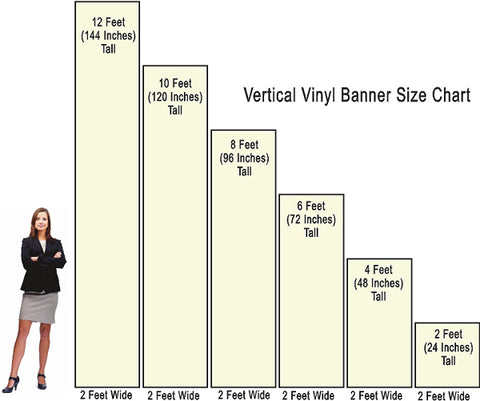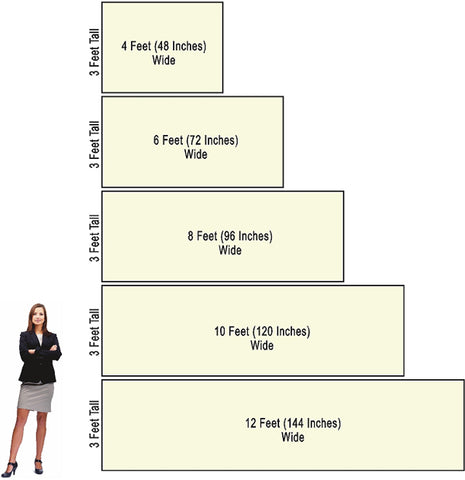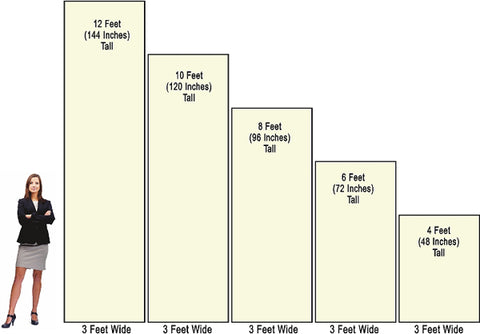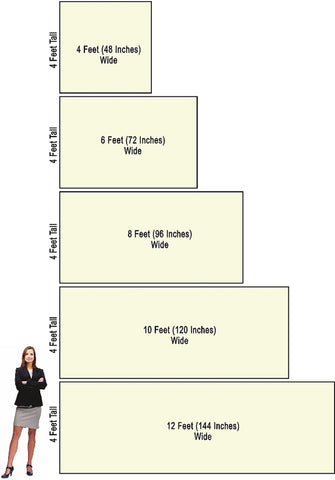Designing a vinyl banner is easy; however, designing an effective vinyl banner may be easily overlooked. Many times, your vinyl banner company offers to provide design services, or they may allow you to submit your own artwork. In this article, let's discuss how exactly to properly lay out not only a visually appealing vinyl banner, but to design a banner effectively that will accomplish your goal!
First, it's important to ask "What's the purpose of my banner?" Is it a "decorative banner" (maybe for a one-day birthday or party where its function is simply to add to the ambiance of the occasion?), or is your banner going to serve as a community announcement for a grand opening or sales event that will be expected to capture attention and results?
Second, how long will your banner "be in service?" Maybe the announcement banner will be hung for 30 to 60 days near a busy intersection whereas the birthday banner may only be hung indoors for three or four hours. Or, maybe you're going to "stretch" the life of your banner to several months or even for as long as the banner will last (many of our clients display banners on their buildings for years!)
Even though banners are considered "temporary signage," we've had clients that have posted our banners for several years before fading or tearing. Your climate plays a huge role in determining how long a banner will last (rain, wind, etc), and the type of materials and inks your banner is produced plays another major part. For example, solvent inks printed on 13oz or heavier vinyl material normally last longer than water based inks printed on lighter weight vinyl materials. If you have a banner supplier who offers "overlaminate" as an option to your banner, you may expect (in normal weather conditions) for your banner to last 50% to 100% longer. If you're planning to purchase a banner that will "live" near water- rainy areas or especially coastlines, please consider asking your banner provider if overlaminate is an option. Water (rain or sea spray) can damage banners really quickly! (Even faster than wind!)
So let's take a look at common vinyl banner sizes.
Banner Sizes and Templates
Banners come in, literally, almost all sizes and shapes, from 1 foot by 1 foot, to those HUGE banners you see draping down from the casinos and sky scrapers in Vegas and "big cities."
Some of our most popular banner sizes include: (click here to download banner size templates)
1' x 3', 1' x 4', 1' x 5', 1' x 6', 1' x 8' (great for pop up tents)
2' x 2', 2'x 4', 2'x 6', 2'x 8', 2'x10', 2'x 12' 2' x 20' (great for parties)
3' x 3', 3' x 4', 3' x 6', 3' x 8', 3' x 10', 3' x 12', 3' x 20' (good for high-traffic purposes)
4' x 4', 4' x 6', 4' x 8', 4' x 10', 4' x 12' 4' x 15', 4' x 20' (GREAT for high-traffic purposes)
5' x 5', 5' x 8' 6' x 6', 6' x 8' 8'x 8', 8' x 10', 8' x 12', 8' x 16' (good for back-drops)
10' x 8', 10' x 10', 10' x 15', and 10' x 20' (GREAT for HUGE high-traffic, such as highways or draping over large structures, or for backgrounds such as concerts, trade shows, etc.)
You can scroll down further to see an illustration of sizes or to download our most common banner templates (click here.)
Since banners come in all sizes, choosing the correct size is very important not only to accomplish your results, but also to save you money. Our most frequently ordered sizes are: 2 feet tall by 6 feet wide, 3 feet tall by 6 feet wide, and 4 feet tall by 8 feet wide. We print hundreds of banners in every size in between, and we also produce back-drop and over-sized banners that range from 8 feet tall to 10 feet wide and even larger.
In general, the size of the viewing area will determine the size for your banner. For indoor parties, a 2 x 6 banner may work perfectly if you're in a smaller or medium size room. But if you're having a party at a convention center, than you will need a 4 x 8 or even larger banner so that the banner will be seen easily by a majority of the people. Or if you're announcing a grand opening or business event that will be hung outdoors near a busy intersection, a 2 x 6 banner may be a complete waste of money (too small to be effective) and you may need a 3 x 6 or 4 x 8 size banner. If you're confused about which size banner to use, simply call us at 866-267-5814 or press live chat and we'll be happy to help.
Banner Features
There are several common features to most banners. First is the weight of the vinyl used for the banner. Many common sizes include 10 oz, 13 oz and even heavier. In general, 13 oz is the most common vinyl weight and works in most uses. You can safely use a less expensive lighter weight banner if your use is very temporary (indoor party,) but make sure you use a heavier weight banner for outdoor banners that will be displayed in windy areas or longer than 2 weeks.
Second, does your banner need to be seamed or sewn for extra durability? Seaming a banner entails that the perimeter of the vinyl being "folded over" and affixed with durable double-sided seam tape. Most banner companies offer seaming as a normal feature; however, you may not need this added benefit, so why not save money? For example, if you're using your banner for an indoor birthday party, it's highly unlikely your banner needs to be seamed unless it's being hung or displayed in a fashion that will cause a lot of tension on the vinyl (such as with ropes or bungee cords)
Third, does your banner require grommets? Grommets are the circular metal rings stamped onto the perimeter of a banner. If your banner is going to be hung with rope or bungee cords, it most certainly will require grommets to provide the means to attach the banner to the chords. However, if your banner is going to be displayed on a board or wall for a short amount of time, you may be able to use tape or staples to affix your banner to the surface, thus saving the unnecessary expense of having your banner company provide grommets as a finish!
Fourth, does your banner need to be sewn (for the seaming process) or will double sided seam tape work? In general, if your use is for pole banners or banners that will be hung for a long time, you may require sewn seams vs. seam tape. But if you're using a banner for a temporary use, seam tape works fine. Seam tape also normally works fine in "normal" weather conditions.
Here's a pictures of a "sewn seam" on a vinyl banner:
 And here's a picture of several grommets prior to being affixed to a vinyl banner:
And here's a picture of several grommets prior to being affixed to a vinyl banner:
 And finally- here's a grommet after being affixed onto a vinyl banner:
And finally- here's a grommet after being affixed onto a vinyl banner:

Seaming with strong and reliable application tape works in most environments and can often save you money!
Designing Your Banner
Many people truly enjoy designing or laying out their banner. It can be a fun and creative process. However, in designing your banner, make sure you keep in mind the overall goal of your banner. If your banner is being used as a decoration at a birthday party, then your goal may be to create the banner to look artistically incredible and designed to highlight or promote the person being celebrated. Fonts, pictures, shadows, effects, and colors that pop may be your first consideration. However, if your banner's goal is to convey a message at a busy intersection, than the message itself is the most important item to consider.
If your banner's goal is the first mentioned above, than there may be few rules to follow. Let your imagination run wild! But if your banner's goal is the second above, here are a few ideas to consider:
1) Go with easily readable fonts. We recommend sans serif fonts (arial is our default) for conveying information such as: SALE! or GRAND OPENING or for phone numbers, domains, addresses, etc. Don't get fancy here. If your viewer is in a car passing by at a high speed, the last thing you want is for them to not be able to read the message because of the font.
2) Use highly contrasting colors. We recommend as our top choices: red on white and black on yellow. Black on white also works well. But stay away from the difficult to read combinations such as red on black, purple on black, or any closely related colors. Lighter colors such as pink and yellow will fade away on a white background. As a rule of thumb, if you print your banner proof on 8.5" x 11" paper, and can't read it easily from @ 5-10 feet
away, than you'll more than likely have trouble with your banner.
3) Keep out the clutter. Whether using your banner for a party or for a business celebration, avoid placing small clutter text that won't be viewed. In fact, if your banner is being used at an intersection as a billboard, you may want to keep the text to a bare minimum: just the message and relevant contact information.
4) Use quality images/files. Remember that your banner will be printed using a wide format printer. Small images and pictures often pixelate when enlarged. As a rule of thumb, if your picture file is under 2 mb, you run the risk that your picture will be blurry when printed (excluding vector images).
5) Save your file correctly for your banner company. Regardless of the type of design program you're using, make sure you size your file correctly and save it in the appropriate format. Common formats include vector, pdf, jpeg, and tiff. Sizing depends on the quality of your file as well as the means to send the file to your banner company. Files larger than 10 mb are difficult to email and require an ftp upload or physical delivery via a disk or memory stick.
Keep in mind that normally your banner will be truncated approximately 1 inch around the perimeter for the seaming and grommeting, so make sure you design your banner with at least a 1 inch bleed. Below are several templates (pdf files) for you to use in designing
your banner which most banner or printing companies should accept for your design.
Click here to download many of our most common vinyl banner templates (pdfs):
Here's a "scale chart" how banners look next to an average, professional "banner model." (Results may vary...).







Check out our LGB Marketing Tips & Articles Here

 And here's a picture of several grommets prior to being affixed to a vinyl banner:
And here's a picture of several grommets prior to being affixed to a vinyl banner: And finally- here's a grommet after being affixed onto a vinyl banner:
And finally- here's a grommet after being affixed onto a vinyl banner:






